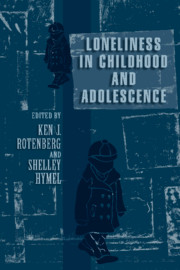Book contents
- Frontmatter
- Contents
- Contributors
- PART I INTRODUCTION
- PART II THEORETICAL AND ASSESSMENT ISSUES
- PART III LONELINESS IN CHILDHOOD
- 6 Loneliness During Early Childhood: The Role of Interpersonal Behaviors and Relationships
- 7 Connections Among Loneliness, the Ability to Be Alone, and Peer Relationships in Young Children
- 8 A Social-Information-Processing Approach to Children's Loneliness
- 9 Parental Antecedents of Children's Loneliness
- 10 Dimensions of Children's Friendship Adjustment: Implications for Understanding Loneliness
- PART IV LONELINESS IN ADOLESCENCE
- PART V PROSPECTIVE
- References
- Author Index
- Subject Index
- Plate section
10 - Dimensions of Children's Friendship Adjustment: Implications for Understanding Loneliness
Published online by Cambridge University Press: 13 October 2009
- Frontmatter
- Contents
- Contributors
- PART I INTRODUCTION
- PART II THEORETICAL AND ASSESSMENT ISSUES
- PART III LONELINESS IN CHILDHOOD
- 6 Loneliness During Early Childhood: The Role of Interpersonal Behaviors and Relationships
- 7 Connections Among Loneliness, the Ability to Be Alone, and Peer Relationships in Young Children
- 8 A Social-Information-Processing Approach to Children's Loneliness
- 9 Parental Antecedents of Children's Loneliness
- 10 Dimensions of Children's Friendship Adjustment: Implications for Understanding Loneliness
- PART IV LONELINESS IN ADOLESCENCE
- PART V PROSPECTIVE
- References
- Author Index
- Subject Index
- Plate section
Summary
Friends are hard to get for me
If you were me, you would see
But since you're not me, you can't see
A friend is hard to get for me
Friends are wise
Friends are guys
Friends are cool
Friends are not cruel
If I had a friend
I would recommend
friends for any other friend
Chad, the 10-year-old boy who wrote this opening verse in response to a routine class writing assignment, is lonely. Chad is not unpopular with his classmates. However, Chad's best friend moved away over the summer and, although it is December, Chad has not formed a comparable friendship with anyone else. According to his teacher, several of Chad's classmates are fond of him and have made social overtures, but thus far none of these potential relationships has taken root. As a consequence, far from the energetic and happy child of last year, this year Chad is frustrated or sad much of the day. Chad's teacher believes that Chad's loneliness has compromised his schoolwork, and she is worried enough to have recommended him to the school psychologist for counseling.
The fact that children experience loneliness when things are not going well in their friendships is evident to anyone who has ever attempted to console a child in Chad's circumstances. Yet, only recently have researchers directly addressed friendship as a factor in children's loneliness, or for that matter, children's friendships more generally (see Bigelow, Tesson, & Lewko, 1996; Bukowski et al., 1996; Gottman & Parker, 1986; Laursen, 1993). Instead, most attention has been given to studying loneliness in relation to children's general acceptance versus rejection from social groups.
- Type
- Chapter
- Information
- Loneliness in Childhood and Adolescence , pp. 201 - 222Publisher: Cambridge University PressPrint publication year: 1999
- 17
- Cited by

